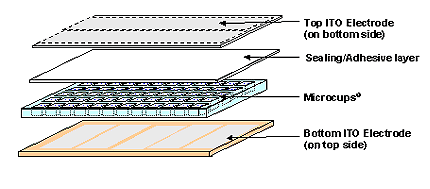 |
Global
functioning :
 
 |
Charged particles move in colour fluid. If the particle is charged, it
moves towards outside and the colour is not visible more. If not, it moves
inside and we can see its colour. |
 |
These
EPD screens are manufactured by Philips on three different technologies:
 |
Direct Drives |
 |
Passive Matrix |
 |
Active Matrix
|
|
|
 |
Direct Drives Microcup EPD Structure :
  
 |
This technology is used to make flexible screens which can only show
coloured segments. Each segment is controlled by a driver. As you can
imagine, this technology is not in advance sufficiently for our product
because we need to show pictures and video.
|
|
 |
Passive Matrix Microcup® EPD
  
 |
With the Passive Matrix technology, you can control lines and columns of
the matrix to access each pixel directly. |
 |
This technology is able to show text with a sufficient average resolution
for re-reading but not for showing pictures or videos. For the moment,
these screens are monochromatic.
|
|
 |
Active Matrix Microcup® EPD
|
 |
Design features of Sipix’s screen technology:
 |
Picture technology:
-
Reflective screen technology
-
Bistabled picture
|
 |
Posting:
-
Large view angle
-
Uniform picture
-
High refresh rate
-
High contrast
-
Still monochromatic (colour will soon arrive)
-
Low
average resolution
|
 |
Flexibility:
-
Totally Roll to roll screen
-
Possibility to choose the size of the screen
|
 |
Portability
:
-
Ultra thin screen (the thinnest of its category)
-
Ultra light
|
 |
Durability
-
Very tough, and perhaps unbreakable
-
Very long lifespan
|
 |
Consumption
-
Low
supply voltage
|
|

![]()
![]()
![]()